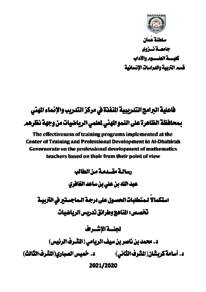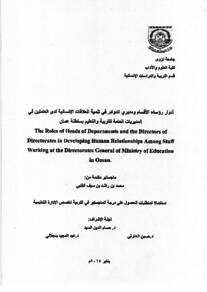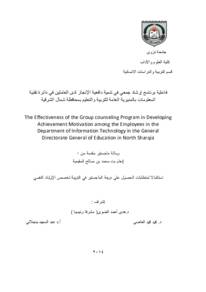Document
المشكلات التعليمية و التدريبية التى تواجهها المعاهد التدريبية الخاصة في سلطنة عمان كما يراها مديرو المعاهد
Publisher
جامعة السلطان قابوس
Gregorian
2000
Language
Arabic
Subject
English abstract
The thesis deals with the educational and training problems facing the private training institutes as perceived by their directors. The study aims at finding out the problems facing these institutes and to suggest the optimum solutions in an attempt to upgrade the abilities and performance of these institutes, improve the quality of training to meet the needs of the national economy in the Sultanate of Oman in the terms of the local qualified labour force. Furthermore, the study intends to help decision makers to chart out appropriate policies and implementation measures to minimize the problems and activate the role of the institutes towards achieving their goals in upgrading the local labour force. The sample of the study consists of (100) private training institutes distributed among the areas and governorates of the Sultanate. To achieve the objectives of the study, a questionnaire was designed to reveal the educational and training problems as perceived by the directors of the private training institutes. The questionnaire includes (40) items covering four dimensions (training texts, teaching methods; trainees; trainers). The validity and reliability of the questionnaire was tested statistically, The SPSS was employed to analyze the data statistically. The mean, standard deviation, and the relative importance for each item of the four dimensions related to educational and training problems being faced by the directors of the private training institutes discussed earlier were calculated. Also, the analysis of variance, means and standard deviations were calculated for each of these dimensions, based on the format related to the educational and training problems being faced by the private training institutes, according to the directors. The results indicate that most important items which scored a mean of greater than 3 are: weakness of trainees in English language, educational background, lack of feeling among the trainees that they are pursuing a profession from the training programmes and the weakness of the trainees enrollment in the training programmes. This means that the fundamental problems being faced by the private training institutes lie in special characteristics of the trainees, knowledge and profession wise. This has led to their minimum absorption and perception of the training programmes. The trainees are forced to this situation owing to lack of motivation and dominating belief that the programmes are not adequate enough for them to secure a profession. Thereby, it has led finally to an increase in the percentage of drop outs in these institutes.
The results also indicated the common agreements of the directors about the existence of problems related to trainees, location, programmes, technical equipment and workshops. However, there exist difference of opinion among directors with regard to training course content and problems related to trainers. The experienced directors emphasize the need for enhancement of training texts and teaching methods, whereas, the less experienced directors think that the training texts and teaching methods are adequate. Adding to that, there was a difference in the opinions of the directors according to their experience regarding the problems related to the trainers and the language of training. Some of the directors reinforce the necessity of English language for training, whereas the others prefer the Arabic language as it facilitates the transformation of information to the trainees. The qualification and the nationality of the directors did not signify the existence of the problems included in the study. All the directors have different views about the problems according to the size of training institute. Some of them report that the size of the institute has positive impact on minimizing the problems, whereas, others think the opposite. Thus, the difference in terms of the size of the institutes was statistically significant. The study has concluded and suggested several recommendations in an attempt to develop the status of the private training institutes in the Sultanate of Oman. These recommendations and suggestions were based on the results of the study and the prevailing trends in vocational training.
Description
رسالة جامعية
Member of
Resource URL
Arabic abstract
تناولت هذه الدراسة موضوع " المشكلات التعليمية والتدريبية التي تواجهها المعاهد التدريبية الخاصة في سلطنة عمان كما يراها مديرو هذه المعاهد ". وتهدف هذه الدراسة إلى الكشف عن المشكلات التي تواجه تلك المعاهد ، واقتراح الحلول الملائمة لرفع مستوى القدرات والأداء لتلك المعاهد ، والنهوض بنوعية التدريب لتلبية احتياجات الاقتصاد الوطني لسلطنة عمان من العمالة الوطنية المؤهلة . بالإضافة إلى أن هذه الدراسة سوف تساعد متخذي القرار على رسم سياسات ، واتخاذ إجراءات تنفيذية للحد من تلك المشكلات ، وتفعيل دور المعاهد نحو تحقيق أهدافها في رفع مستوى الأيدي العاملة الوطنية . وقد تألفت عينة الدراسة من (۱۰۰) معهد تدريبي خاص موزعة في جميع مناطق ومحافظات السلطنة . ولتحقيق أهداف الدراسة تم استخدام استبانة قامت الباحثة ببنائها لمعرفة واقع المشكلات التعليمية والتدريبية التي تواجهها المعاهد التدريبية الخاصة في سلطنة عمان. وقد تكونت الاستبانة من (40) فقرة موزعة على أربعة أبعاد هي : المحتوى التدريبي والأساليب التعليمية ، والمتدربين ، والمدربين، والموقع والبرامج والتجهيزات الفنية وورش العمل . وقد تم التأكد من صدق الاستبانة وثباتها . وقد تم قياس تلك الأبعاد وفقا للمتغيرات المستقلة التالية : خبرة ومؤهلات مدير المعهد التدريبي ، وجنسية مدير المعهد ، وطبيعة عمل المعهد (إداري ، فني، حرفي) وحجم المعهد التدريبي . واستخدمت الرزمة الإحصائية للعلوم الاجتماعية (SPSS) في معالجة البيانات إحصائيا ، حيث استخرجت المتوسطات، والانحرافات المعيارية، والأهمية النسبية (الرتبة) لكل فقرة من الفقرات المكونة الأبعاد الأربعة المتعلقة بالمشكلات التعليمية والتدريبية التي تواجه مديري المعاهد التدريبية الخاصة . كذلك تم حساب المتوسطات، والانحرافات، والأهمية النسبية وتحليل التباين الأحادي لكل بعد من الأبعاد المكونة للاستبانة المتعلقة بالمشکلات التعليمية والتدريبية التي تواجهها المعاهد التدريبية الخاصة من وجهة نظر مديريها. وقد أبرزت نتائج الدراسة أن أهم الفقرات التي حصلت على متوسط مقداره (۳) فأكثر هي : قلة إلمام المتدربين باللغة الإنجليزية ، والمستوى التحصيلي السابق الذي يؤثر على مدى استفادتهم من البرامج التدريبية ، وعدم شعور المتدربين بأنهم يكتسبون مهنة من البرامج التدريبية ، وضعف إقبال المتدربين على البرامج التدريبية . وهذا يعني أن جوهر المشكلات التي تواجه المعاهد التدريبية الخاصة يكمن في خصائص المتدربين العلمية والمسلكية ، مما أسهم في تدني استيعابهم لمحتوى البرامج التدريبية . وهذا فرض على المتدربين ضعف الدافعية ، وسيادة الاعتقاد بأن البرامج غير كافية لإكسابهم مهنة ، مما أدى في النهاية إلى زيادة نسبة التسرب من تلك المعاهد . كذلك أظهرت النتائج إجماعا من قبل المديرين على وجود مشکلات متعلقة بالمتدربين، ومشکلات متعلقة بالموقع ، والبرامج ، والتجهيزات الفنية ، وورش العمل . وقد اختلفت آراء المديرين وفق خبراتهم من حيث المحتوى التدريبي والمشكلات المتعلقة بالمدربين . إذ يرى ذوو الخبرة تعزيز المحتوى التدريبي والأساليب التعليمية ، في حين يرى محدودو الخبرة كفاية المحتوى والأساليب التعليمية . واختلفت آراء المديرين وفق خبراتهم حول المشكلات المتعلقة بالمدربين ، ولغة التدريب المستخدمة ، إذ يرى بعضهم ضرورة استخدام اللغة الإنجليزية في التدريب ، بينما يرى البعض الآخر استخدام اللغة العربية على اعتبارها تسهل إيصال المعلومات المطلوبة للمتدربين . ومن جهة أخرى، أجمع المديرون على وجود المشكلات التي تضمنتها الدراسة ، بغض النظر عن مؤهلاتهم العلمية وجنسياتهم . كذلك أجمع المديرون على اختلاف تلك المشكلات باختلاف أحجام المعاهد التدريبية الخاصة . حيث يرى بعضهم إيجابية حجم المعهد في تلافي تلك المشكلات ، بينما يرى البعض الآخر عكس ذلك . ومن هنا جاءت الفروق كبيرة وذات دلالة إحصائية . وتوصلت الدراسة إلى مجموعة من التوصيات والمقترحات لتطوير واقع المعاهد التدريبية الخاصة في سلطنة عمان في ضوء نتائج الدراسات والاتجاهات الحديثة للتدريب المهني
Category
Theses and Dissertations







